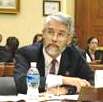
White House Posts Update on H1N1 Preparedness
The update responds to recommendations from the President's Council of Advisors on Science and Technology, which completed a report on flu readiness that is also on the White House Web site.
This week, the White House posted a new report about the nation's readiness for H1N1 influenza. The President's Council of Advisors on Science and Technology (PCAST) had assembled a subcommittee of experts on influenza and public health to assess and report on the situation; the PCAST report is online, as is a summary listing the group's recommendations and progress to date for each.
"As the nation prepares for what could be a challenging fall, it is crucial that our public health decisions are informed by the very best scientific and technological information," said John P. Holdren, assistant to President Obama for Science and Technology and a co-chair of PCAST, said in the White House news release dated Aug. 24.
The PCAST recommendations and progress on them:
- Accelerate vaccine availability to mid-September by having manufacturers "fill and finish" some of the vaccine at 15 micrograms. Progress: All five manufacturers have been asked to put their initially available vaccine in vials as soon as possible, which will ensure earliest possible availability of initial doses.
- Upgrade the national surveillance system. Progress: HHS and CDC are expanding the system to track emergency department visits and admissions for influenza-like illness (ILI) and are providing test kits and devices to 140 public health labs to test for H1N1 and other flu subtypes. CDC is adding about 900 more sentinel clinic providers to improve tracking on ILI.
- Address financial and regulatory barriers that could prevent school districts from shutting schools when public health conditions warrant closure. Progress: A Department of Education legal team has fast-tracked exploring how to waive certain federal educational requirements that "could inadvertently hurt schools with high rates of flu-related absenteeism." DOE, with CDC, has issued H1N1 guidance for schools and higher education.
- Strengthen CDC guidelines for antivirals, communicating this to health departments, health care practitioners, and the public. Progress: CDC is revising interim guidance as suggested and expects the revision to be completed by the end of August.
- Accelerate FDA decision about the availability of antivirals. Progress: FDA is actively engaged with manufacturers, and work is being done to facilitate their availability through an Emergency Use Authorization if necessary.
- CDC should communicate through new media and social networking, in additional to traditional media. Progress: CDC's emergency Twitter has more than 300,000 followers, up from 30,000 at the start of the Spring 2009 H1N1 outbreak. CDC will expand this throughout the fall and winter flu season, including using Facebook and MySpace.
- CDC should harmonize its recommendations with relevant professional societies such as SHEA, the Infectious Diseases Society of America, and the American Academy of Pediatrics. Progress: CDC is in frequent discussions with associations and clinicians.